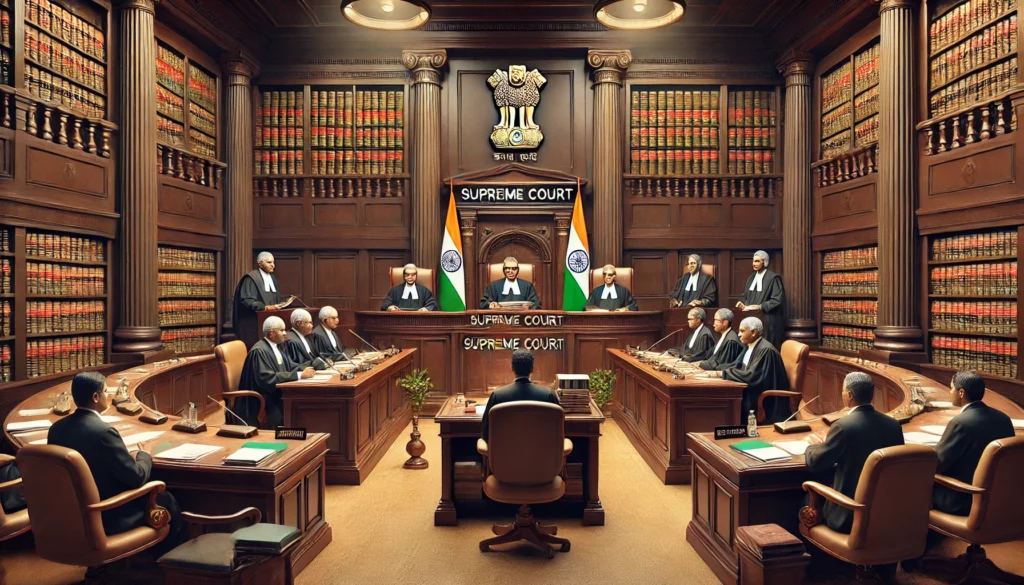This article has been written by Rehana Iqbal Imani, a 2nd year law student from Balaji School of Law, Pune – 411033
IN THE HON’BLE SUPREME COURT OF INDIA
PETITIONER – RENJITH KG & ORS.
Vs.
RESPONDENT – SHEEBA
CITATION – 2024 LiveLaw (SC) 798 / 2024 INSC 773
DATE OF JUDGEMENT – October 14, 2024
HON’BLE JUDGES – Justices A.M. Khanwilkar, Dinesh Maheshwari, A.S. Bopanna and S. Ravindra Bhat
COUNSEL FOR THE APPELLANTS: Sanand Ramakrishnan
COUNSEL FOR THE RESPONDENTS: Nishe Rajen Shonker
INTRODUCTION
In Renjith KG & Ors. v. Sheeba, the Supreme Court of India clarified the legal position regarding the rights of pendente lite transferees. The Court ruled that such transferees, being third parties to the original suit, possess the right to file an application under Order 21 Rule 99 of the Code of Civil Procedure, 1908 (“CPC”) to contest dispossession from the property involved in ongoing litigation. This decision underscores the importance of protecting the interests of individuals who acquire property during the pendency of legal disputes.
FACTS
The appellants, Renjith KG and others, acquired property from the original owner while a suit involving that property was pending. Despite their legitimate acquisition, they faced dispossession initiated by the respondent, Sheeba, who argued that the appellants had no rights due to the ongoing legal proceedings. The appellants contended that their rights should be upheld and sought relief against the dispossession.
ISSUES
- Does a pendente lite transferee have the right to contest dispossession from property that is subject to ongoing litigation?
- Is an application under Order 21 Rule 99 of the CPC maintainable for a third party not involved in the original suit?
ARGUMENTS OF THE PETITIONER
The appellants argued that their acquisition of the property was valid and that the law protects third parties who acquire interests during litigation. They emphasized that denying them the ability to contest dispossession would infringe upon their property rights and disrupt the legal certainty surrounding transactions.
ARGUMENTS OF THE RESPONDENT
The respondent maintained that the appellants, being third parties, lacked standing to challenge the dispossession, as they were not part of the original suit. The respondent argued that the rights established in the original litigation should take precedence over any subsequent claims made by the appellants.
COURT’S REASONING
The Supreme Court concluded that pendente lite transferees are entitled to seek relief under Order 21 Rule 99. The Court reasoned that allowing such transferees to contest dispossession is essential to uphold the principles of justice and fairness. It highlighted that individuals acting in good faith should not suffer due to the ongoing disputes between original parties.
PRECEDENT ANALYSIS
The judgement referenced previous case law establishing the rights of third-party transferees during ongoing litigation. The Court’s interpretation emphasized that legal protections apply to pendente lite transferees, thereby reinforcing their right to contest actions that may infringe upon their acquired interests.
JUDGEMENT
The Supreme Court ruled in favour of the appellants, affirming their right to file an application under Order 21 Rule 99. The Court recognized the necessity of protecting the rights of pendente lite transferees against dispossession, establishing a clear legal precedent for similar cases in the future.
ANALYSIS
This ruling is significant for property law, as it clarifies the legal standing of individuals who acquire property during ongoing litigation. It emphasizes the importance of safeguarding property rights, thereby fostering confidence in transactions that occur in the midst of legal disputes.
CONCLUSION
The Supreme Court’s decision in Renjith KG & Ors. v. Sheeba reinforces the legal protections available to pendente lite transferees, ensuring that their rights are recognized even in the face of dispossession. This case contributes to a more robust understanding of property rights and the legal framework surrounding them, especially during litigation.
REFERENCES:
- Case Citation: Renjith KG & Ors. v. Sheeba, Civil Appeal Nos. 8315-8316 of 2014, (2024) LiveLaw (SC) 798.
- Verdictum
Renjith KG & Ors. v. Sheeba, 2024 INSC 773, available at https://www.verdictum.in/court-updates/supreme-court/renjith-kg-v-sheeba-2024-insc-773-third-party-to-a-decree-has-a-right-to-approach-court-even-after-dispossession-of-immovable-property-1554700?infinitescroll=1. - Supreme Today
Renjith KG & Ors. v. Sheeba, available at https://supremetoday.ai/doc/judgement/00100079951. - LiveLaw
Renjith KG & Ors. v. Sheeba, (2024) LiveLaw (SC) 798, available at https://www.livelaw.in. - SCC Online
Renjith KG & Ors. v. Sheeba, available at https://www.scconline.com - Statutory References (CPC):
- Code of Civil Procedure, 1908
- Order 21, Rule 99: This section allows a third party, who claims to be dispossessed of immovable property, to apply to the court to restore possession.

